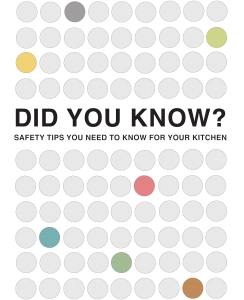 As a Homemaker, keeping your people safe from food poisoning is one of your most important responsibilities.
As a Homemaker, keeping your people safe from food poisoning is one of your most important responsibilities.
Did you know that…?
- According to the FDA, “there are about 48 million cases of foodborne illness annually—the equivalent of sickening 1 in 6 Americans each year…”
- At greatest risk to the bacteria or pathogens that can contaminate food are young children, pregnant women, the elderly and individuals with weakened immune systems.
- Food poisoning can be serious—even fatal—resulting each year (in the US) “in approximately 128,000 hospitalizations and 3,000 deaths.”
We’ll be sharing more information in the future concerning food safety, but in the meantime…
HERE ARE THREE OF THE LATEST GUIDELINES you should know about from the new food code for Washington State effective May 1, 2013…
New Guidelines:
- “Minimum Hot Holding Temperature drops to 135 degrees F. The current cold holding temperature (41°F) will remain the same.”
[Note: This refers to what is commonly known as “The Danger Zone” for foods. When Potentially Hazardous Foods (PHFs) are allowed to sit in the range between these two temperatures for longer than two hours, bacteria or pathogens can multiply rapidly. The food can become poisonous and make people sick. The old “Danger Zone” used to be between 41°F-140°F.]
- “Cut leafy greens, salads, and cut tomatoes must now be refrigerated. Potentially Hazardous Food (PHF) need to be kept hot or cold for safety. PHF includes meat, poultry, cooked starches, sliced melons, sprouts, fresh herb and garlic-in-oil mixtures, dairy products, and cooked produce. Like other PHF, cut leafy greens and cut tomatoes will now need to be kept out of the Danger Zone (41-135°F).
“Cut leafy greens” means fresh leafy greens whose leaves have been cut, shredded, sliced, chopped, or torn. The term “leafy greens” includes iceberg, romaine, leaf lettuce, butter lettuce, baby leaf, escarole, endive, spring mix, spinach, cabbage, kale, arugula and chard. The term “leafy greens” does not include herbs such as cilantro or parsley. The term “cut” does not include removing and discarding the exterior leaves.”
- “All produce is required to be rinsed under running potable water. Produce must be washed under running water before being cut, peeled or otherwise prepared for service. Produce that has been soaked or crisped must also be rinsed under running water. Sprouts and herbs must follow this procedure as well.”
Sources:
http://www.fda.gov/Food/FoodborneIllnessContaminants/BuyStoreServeSafeFood/ucm255180.htm
https://www.foodworkercard.wa.gov/information.aspx?lid=LG1&lname=English&lfldr=en-us&strType=ONLINE
